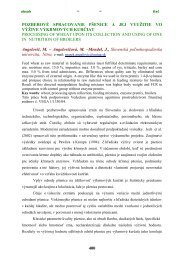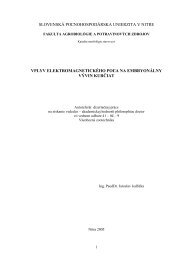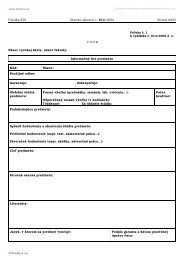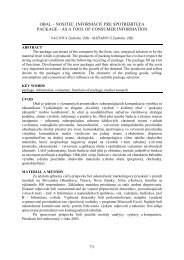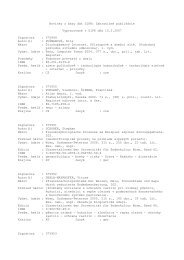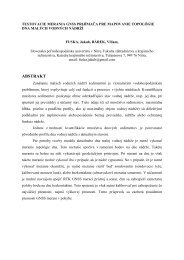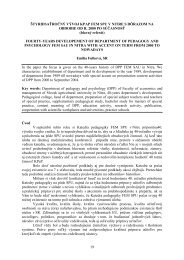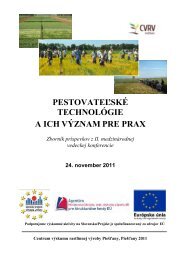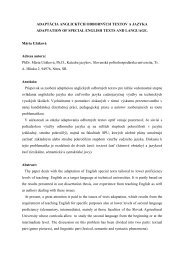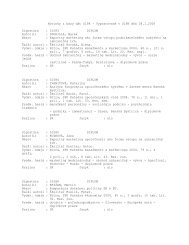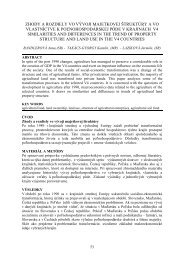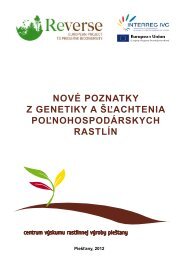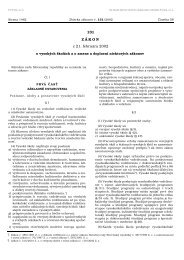Acta fytotechnica et zootechnica, Vol. 4, 2001, Special Number ...
Acta fytotechnica et zootechnica, Vol. 4, 2001, Special Number ...
Acta fytotechnica et zootechnica, Vol. 4, 2001, Special Number ...
Create successful ePaper yourself
Turn your PDF publications into a flip-book with our unique Google optimized e-Paper software.
<strong>Acta</strong> <strong>fytotechnica</strong> <strong>et</strong> <strong>zootechnica</strong>, <strong>Vol</strong>. 4, <strong>2001</strong>, <strong>Special</strong> <strong>Number</strong><br />
Proceedings of the International Scientific Conference on the Occasion of the 55 th Anniversary of the Slovak Agricultural<br />
University in Nitra<br />
Figure 3 Figure 4<br />
Ročný chod atmosferických zrážok za ročník 1999/2000<br />
Average rainfalls 1999/2000<br />
Ročný chod teploty za ročník 1999/2000<br />
Average temperatures 1999/2000<br />
100<br />
25,0<br />
Zrážky (mm)<br />
90<br />
80<br />
70<br />
60<br />
50<br />
40<br />
30<br />
20<br />
10<br />
0<br />
58<br />
47,1<br />
37<br />
7,1<br />
41<br />
32,7<br />
54<br />
49,7<br />
43<br />
40,9<br />
23 22,2<br />
94,2<br />
31 32 33<br />
43<br />
23,6<br />
55<br />
31,7<br />
70<br />
5,2<br />
64,3<br />
64<br />
Teplota (°C)<br />
20,0<br />
15,0<br />
10,0<br />
5,0<br />
0,0<br />
19,2<br />
19,0<br />
15,4<br />
18,1<br />
10,1<br />
9,7<br />
4,9<br />
3,7<br />
0,5<br />
-0,1<br />
VIII. IX. X. XI. XII. I. -1,7 II. III. IV. V. VI. VII.<br />
-2,2<br />
3,2<br />
0,5<br />
5,3<br />
4,7<br />
13,8<br />
10,1<br />
17,2<br />
14,8<br />
20,4<br />
18,3<br />
19,7<br />
19<br />
VIII. IX. X. XI. XII. I. II. III. IV. V. VI. VII.<br />
Mesiac<br />
-5,0<br />
Mesiac<br />
Z (mm) Kl.normál 1951-1980<br />
t (°C) Kl.normál 1951-1980<br />
Results and discussion<br />
Results have shown possibility of a partial elimination of injurious climatic influence on the yield formation by soil cultivation<br />
ways. In the season 1998/1999 with extremely rainy autumn – September 404.3%, October 190% (Figure 1,2), barley sowing<br />
delayed till the 30th October. The stand rose only for 55-60% till winter. That is why the formation of the basic yield-formation<br />
element – number of plants - was influenced negatively. Extremely w<strong>et</strong> autumn was relieved by dry winter and spring period,<br />
which influenced negatively the shoot formation and the total number of spikes (this was 426 to 440 pcs per m 2 in multirowed<br />
vari<strong>et</strong>y Luxor, 486 to 628 pcs per m 2 in two-rowed vari<strong>et</strong>y Hanna and 457 to 548 pcs per m 2 in Babylone). P<strong>et</strong>r, Pflug,<br />
Šnejdar (1985) consider as the optimal one 400 – 600 spikes per square m<strong>et</strong>er, Molnárová (1990) more than 500 spikes. In<br />
two-rowed vari<strong>et</strong>ies figure Kufelj (1999) as optimal one 734 – 747 spikes per square m<strong>et</strong>er. There was observed an different<br />
reaction to single soil cultivation ways by examined vari<strong>et</strong>ies.<br />
Average grain yield in season 1998/1999 ranged from 6,65 t.ha -1 (Babylone) to 7,74 t.ha -1 (Luxor). Luxor and Hanna vari<strong>et</strong>ies<br />
reached the highest yield amount by shallow soil cultivation m<strong>et</strong>hod (C), Babylone by ploughing up to 0.20 m + post-harvest<br />
remainders (A) (Table 1).<br />
The yield difference b<strong>et</strong>ween the multi-rowed vari<strong>et</strong>y Luxor and two-rowed vari<strong>et</strong>ies was statistically highly significant.<br />
In season 1999/2000 was the total amount of precipitation for 232,7 mm lower compare to previous year and it reached only<br />
78.7% (Figure 3,4). Contrary to previous year was September extremely dry, with total precipitations of 7.1 mm (19.2% ).<br />
This dry period delayed till the third decade of October, with total precipitations of 6,8 mm. The stand came up compl<strong>et</strong>ely<br />
only in the case of shallow tillage (C). Incoming favourable precipitation during the shoot growing phase ensured good<br />
shooting and that is why also by lower plant number in A,B treatments was a good stand cover contributing to the yield.<br />
Grain yield comparing to the previous year amount was statistically highly significant higher for 0.44 to 1.14 tons per hectare.<br />
Similar as in the previous year, in average for the whole experiment, the highest yield was in the multi-row vari<strong>et</strong>y Luxor (8.18<br />
t.ha -1 ). Positive reaction to the shallow soil cultivation was noticed by Luxor (8.61 t.ha -1 ) and Tiffany (7.75 t.ha -1 ). Babylone<br />
react more positively on conventional tillage (A, B) (Table 2). These results partially confirm the opinion of Procházková,<br />
Dovrtěl and Suškevič (1997), according to them it is important to adapt the soil cultivation system in the corn production area<br />
to moisture conditions and to apply the shallow tillage especially during dry years.<br />
References<br />
Kufelj, D.: Produkčný a akumulačný potenciál jačmeňa dvojradového ozimného. Doktorandská dizertačná práca, Nitra, 1999,<br />
143 s.<br />
Kováč, K.,- Marko, F.: Vplyv obrábania pôdy na úrodu a ekonomiku pestovania ozimnej pšenice. In: Zborník : Obilniny, Nitra<br />
1997, s. 12-17.<br />
Molnárová, J.: The influence of fertilization, time of sowing and sowing rates on corn yield of winter barley in weatherly<br />
different year´s crops. Poľnohospodárstvo,1990, ročník 36, č. 7, s. 596-606.<br />
Molnárová, J.,- Žembery, J.: Produkcia pšenice l<strong>et</strong>nej- ozimnej v trikultúrnej sústave pri rôznych vstupoch. Zborník :<br />
Obilniny, Nitra 1997, s. 36-40.<br />
P<strong>et</strong>r, J. – Pflug, L. – Šnejdar, Z.: Dynamika odnožování ozimého ječmene a podíl odnoží na výnosu. Rostl. Výr. 31, 5, 1985,<br />
s. 507-515.<br />
25



